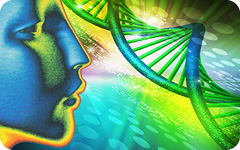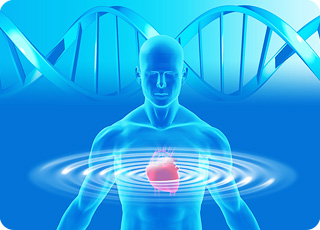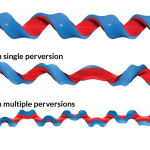Emotions Can Change Your DNA
Cheer up and think positive thoughts: We all give words of advice like these at some time to a friend, relative or colleague who is ill, worried or otherwise out of sorts. Can’t hurt. Right? 
Actually, scientific evidence in the last half century clearly shows that your emotions – the good ones and the bad – affect you in multiple ways: health, schoolwork, job performance, relationships and much more. Whether you feel them naturally or intentionally – today I will think only good thoughts – your emotions are kind of like the old adage, “you are what you eat.”
Throughout much of human history, academic scrutiny of emotions was largely the province of philosophers. Historical records abound from the ancient Chinese, Greeks and other cultures with philosophical discussions about human emotions. The nature and meaning of emotions was prominent in the minds and writings of Confucius, Plato, Aristotle, Descartes, St. Thomas Aquinas and Machiavelli among others.
It was not until the 19th century … that substantial written empirical analyses of emotions began to emerge, when noteworthy figures such as Darwin and Freud took more scientific approaches.
After being within the domain of philosophers for thousands of years, emotions are now closely scrutinized in 21stcentury research laboratories, where scientists can actually observe their effects on human DNA.
Cell biologist Glen Rein … and IHM Research Director Rollin McCraty conducted a series of experiments in the early 1990s involving DNA and intentionally generated emotions. A decade later interest in these experiments persisted. After numerous requests, McCraty summarized their data and published the results of the research in 2003 in a brief report titled Modulation of DNA Conformation by Heart-Focused Intention.
“The results provide experimental evidence to support the hypothesis that aspects of the DNA molecule can be altered through intentionality,” Rein and McCraty wrote. “To our knowledge, this study was the first to correlate specific electrophysiological modes with the ability to cause changes in a biological target (DNA) external from the body. The data indicate that when individuals are in a heart-focused, loving state and in a more coherent mode of physiological functioning, they have a greater ability to alter the conformation (shape or structure) of DNA.”
 Participants in the experiments … included a test group of individuals trained and experienced in HeartMath’s coherence-building techniques and a control group who were not. Each test group participant held a DNA sample in a test tube and was directed to use three different methods – one at a time in separate trials – to make a sample wind or unwind. Each control group participant only focused on achieving the same result using one method.
Participants in the experiments … included a test group of individuals trained and experienced in HeartMath’s coherence-building techniques and a control group who were not. Each test group participant held a DNA sample in a test tube and was directed to use three different methods – one at a time in separate trials – to make a sample wind or unwind. Each control group participant only focused on achieving the same result using one method.
‘Intention’ Shown to Be Potent Force
Editor’s note: Many Institute of HeartMath members, supporters and followers may recall past discussions and references related to the institute’s research on the effects of emotions on human DNA. Here we refresh the record with another look at some of the fascinating findings for those of you who are new to HeartMath and unfamiliar with them. Look for further reading and tools at the end of this article.
Following are the methods each group used to try to affect DNA samples:
- Hold the intention of causing the DNA to change while maintaining a heart-focused state, generating feelings of love and appreciation.
- Maintain a heart-focused state, but with no intention of causing the DNA to change.

- Have the intention of causing the DNA to change while in your normal state.
- Maintain a heart-focused state with the intention causing the DNA to change.
Results
- “Individuals capable of generating high ratios of heart coherence … were able to alter DNA conformation according to their intention,” Rein and McCraty found. Generally, participants with the highest levels of coherence affected the samples the most.
- “Control group participants showed low ratios of heart coherence and were unable to intentionally alter the conformation of DNA. It is important to note that both the intention to cause a change and heart coherence were important variables in the outcomes of the experiments.”
Nonlocal studies … In their report, Rein and McCraty addressed the issue of whether test subjects’ physical proximity to DNA samples – they did, after all, hold the test tubes in their hands during the experiments – could cause them to change in any way. The issue was whether the energy from the electromagnetic field generated by the human heart could make changes to the DNA samples.
“A number of nonlocal studies in which people hold an intention to affect a biological system over longer distances have also revealed dramatic effects,” Rein and McCraty wrote. “In these studies the distance between the targets and the people holding the intention are well beyond the range at which conventional electromagnetic fields could conceivably mediate the effect.”
They cited one of the nonlocal studies they conducted in which an individual was 0.5 miles away from a DNA sample. “In this example, the intention was to increase the winding of the DNA. … Results from a series of five nonlocal trials (including the 0.5-mile test) demonstrated a significant change in DNA conformation.”
The results of Rein and McCraty’s experiments … raises some interesting possibilities, which they discuss in their report.
“While the DNA utilized in this experiment was derived from an exogenous (external) source, it is likely that an individual’s own DNA would be more ‘tuned’ or resonant, and therefore even more responsive, to that person’s intentions,” they said. “Thus, though clearly in need of further testing, it is conceivable that individuals could influence their own DNA through a top-down process such as that described … potentially producing effects of even greater magnitude than those observed in this study.”
Following are other potential implications from these experiments. The authors note that they require further research:
- Because the changes in DNA in these experiments actually occur biologically in a number of vital cell functions, including DNA replication and repair, the concept that human intention can influence processes in human cells is supported.
- The finding that heart coherence was key in achieving the results of these experiments may help lead to a better understanding of the role of positive feelings and attitudes in these critical areas: health and healing; phenomena such as the placebo effect; spontaneous remission in cancer; the health rewards of a strong faith; and the positive effects of prayer.


